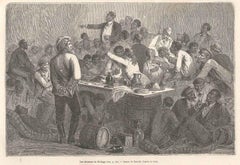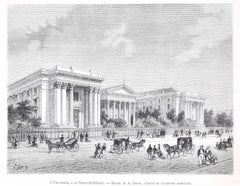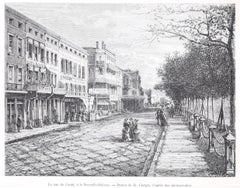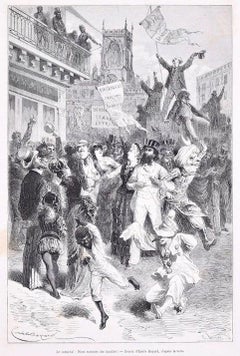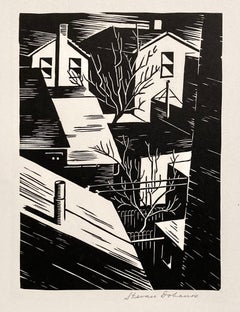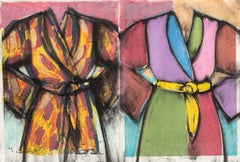Charles Laplante Art
to
4
Overall Width
to
Overall Height
to
4
4
3
1
3
3
2
2
2
1
1
1
1
1
1
1
1
4
4
8,816
2,808
1,655
1,313
Artist: Charles Laplante
Les Sénateurs de Kellogg - Original Woodcut Print After Bertall - 1880s
By Charles Laplante
Located in Roma, IT
Image dimensions: 15.8 x 23.5 cm.
Les sénateurs de Kellogg is a wonderful black and white xilograph on paper, realized around 1880's by the French wooden engraver Charles Laplante (...
Category
1880s Modern Charles Laplante Art
Materials
Woodcut
L'Université - View of New Orleans - Woodcut Print After A. Deroy - 1880
By Charles Laplante
Located in Roma, IT
Image dimensions: 11.7 x 15.5 cm.
L'Université is a wonderful black and white xylograph on paper, realized in 1880 by the French artist Charles Laplante (Sévres 1837 - Paris, 1903),...
Category
1880s Modern Charles Laplante Art
Materials
Woodcut
La Rue du Canal - View of New Orleans - Woodcut Print After Hubert Clerge - 1880
By Charles Laplante
Located in Roma, IT
Image dimensions: 11.8 x 15.4 cm.
La rue du Canal is a beautiful black and white xilograph on paper, realized in 1880 by the French wooden engraver Charles Laplante (Sèvres, 1837 - Paris, 1903), after Hubert Clerget (1818-1899).
Original title: La rue du Canal, à la Nouvelle-Orléans
Signed on plate on sides.
With an incredible freshness of line and a full mastery of the artistic technique, this original print portrays a wonderful glimpse of a street in New Orleans.
Title on plate, on lower margin at the center. The original print is mounted in a white cardboard passepartout, cm 30 x 40.
In excellent conditions, this beautiful modern artwork is an illustration of the French newspaper " Le Tour du Monde", and on the back has another illustration representing the general Sherman...
Category
1880s Modern Charles Laplante Art
Materials
Woodcut
Le Carnaval - Original Woodcut Print After Emile Bayard - 1880
By Charles Laplante
Located in Roma, IT
Image dimensions: 23.5x15.7 cm.
Le carnaval is a wonderful black and white xilograph on paper, realized in 1880 by the French wooden engraver Charles Laplante (Sèvres, 1837 - Paris, 1903), after the French illustrator Emile Bayard...
Category
1880s Modern Charles Laplante Art
Materials
Woodcut
Related Items
Stevan Dohanos, Backyard
By Stevan Dohanos
Located in New York, NY
Stevan Dohanos was an accomplished draftsman who work was widely known through the Saturday Evening Post. This print 'Backyard,' however, leaves aside the illustrative magazine work ...
Category
1930s American Modern Charles Laplante Art
Materials
Woodcut
Winter on Cruise
By Jim Dine
Located in New York, NY
A very good impression of this color woodcut and lithograph diptych. Signed and dated in pencil by Dine. From a limited edition of 12.
Category
Early 2000s Modern Charles Laplante Art
Materials
Color, Lithograph, Woodcut
Walter DuBois Richards, The Lobster Float
By Walter DuBois Richards
Located in New York, NY
Ohio-born Walter DuBois Richards (1907-2006) was educated at the Cleveland School of Art. He re-located to New York around 1933 where he had a successful career as a commercial artis...
Category
1930s American Modern Charles Laplante Art
Materials
Woodcut
Joseph Zirker, Playhouse
By Joseph Zirker
Located in New York, NY
In the 1950s woodcuts started to get bigger and bigger as they competed with paintings for a space on the wall. This California print by Joseph Zirke...
Category
1950s American Modern Charles Laplante Art
Materials
Woodcut
Dan Burne Jones, Affection
Located in New York, NY
Dan Burne Jones is widely know as the author of the Rockwell Kent print catalogue raisonne. It's so interesting to see that he is a gifted wood engraver as well. Jones's own prints a...
Category
1930s American Modern Charles Laplante Art
Materials
Woodcut
Albert Abramovitz, Mission, California
By Albert Abramovitz
Located in New York, NY
Albert Abramovitz was an amazingly skilled wood engraver. This California Mission scene is unusual in his work, but carries the subject so well. It is signed and titled in pencil.
Category
1940s American Modern Charles Laplante Art
Materials
Woodcut
Wedding Party
Located in Buffalo, NY
An original mid century modern woodblock print.
This work is hand signed illegibly and titled "Wedding Party".
Category
1960s Modern Charles Laplante Art
Materials
Paper, Woodcut
Modern American Industrial Landscape
Located in Buffalo, NY
An original woodblock print dated 1965, titled "Our Town" but signed illegibly.
Category
1960s American Modern Charles Laplante Art
Materials
Paper, Woodcut
No Footprints Show, Where the Flowers Grow Deep
By Shiko Munakata
Located in Fairlawn, OH
No Footprints Show, Where the Flowers Grow Deep
Woodcut, 1961
Unsigned (as isssued)
From: The "Way" of the Woodcut, three woodcuts, 1961
Publisher: Pratt Adlib Press, Brooklyn, New Y...
Category
1960s Modern Charles Laplante Art
Materials
Woodcut
Peace
By Anton Refregier
Located in Fairlawn, OH
Peace
Woodcut printed in orange red ink on japanese paper
Signed and titled in pencil lower right (see photo)
Titled lower left (see photo)
Created along with an illustrated book project Song of Peace, 1950-1959.
Condition: Excellent
Image: 10 1/2 x 4 7/8"
Sheet: 16 1/8 x 7";
Anton Refregier (March 20, 1905 – October 10, 1979) was a painter and muralist active in Works Progress Administration Federal Art Project commissions, and in teaching art. He was a Russian immigrant to the United States.
Among his best-known works is his mural series The History of San Francisco, located in the Rincon Center in downtown San Francisco, California. It depicts the city's history across twenty seven panels that he painted from 1940 to 1948.
Life and early career
Refregier was born in Moscow and emigrated to the United States in 1920. After working various odd jobs in New York City, he earned a scholarship to the Rhode Island School of Design in 1921. After finishing school, Refregier moved back to New York in 1925. To earn a living, Refregier worked for interior decorators, creating replicas of François Boucher and Jean-Honoré Fragonard paintings...
Category
1950s American Modern Charles Laplante Art
Materials
Woodcut
Sidney Chafetz, The Stroller (Wallace Stevens)
Located in New York, NY
Sidney Chafetz was known for his clever compositions and his many portraits, all made in the most 'difficult to control' medium of woodcut.. This charmi...
Category
1970s American Modern Charles Laplante Art
Materials
Woodcut
Ted Davies, El Station (New York City), woodcut
By Ted Davies
Located in New York, NY
In the 1950s woodcuts were getting bigger and bigger. This one isn't gigantic, but at an image size of 17 x 11 inches it is substantial. And of course NYC's El Trains and their stati...
Category
Mid-20th Century American Modern Charles Laplante Art
Materials
Woodcut
Charles Laplante art for sale on 1stDibs.
Find a wide variety of authentic Charles Laplante art available for sale on 1stDibs. You can also browse by medium to find art by Charles Laplante in woodcut print and more. Much of the original work by this artist or collective was created during the 19th century and is mostly associated with the modern style. Not every interior allows for large Charles Laplante art, so small editions measuring 9 inches across are available. Customers who are interested in this artist might also find the work of Maxime Lalanne, Charles Courtry, and Auguste Lançon. Charles Laplante art prices can differ depending upon medium, time period and other attributes. On 1stDibs, the price for these items starts at $251 and tops out at $334, while the average work can sell for $273.
